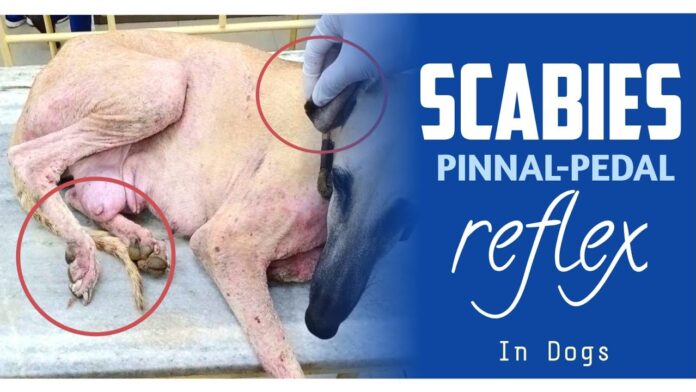Importance of Pinnal-Pedal Reflex in the Diagnosis of Canine Scabies or Mite Infestation (Mange, Acariasis, Scabies) in Dogs
Canine scabies manifests as a disease that is caused by Sarcoptes scabiei var. canis, a superficial burrowing skin mite. Mites secrete allergenic substances that elicit an intensely pruritic hypersensitivity reaction in sensitized dogs. Canine scabies is common in dogs. Affected dogs often have a previous history of being in an animal shelter, having contact with stray dogs, or visiting a grooming or boarding facility. In multipledog households, more than one dog is usually affected. Canine scabies is a nonseasonal intense pruritus that responds poorly to corticosteroids. Lesions include papules, alopecia, erythema, crusts, and excoriations. Initially, less-hairy skin is involved, such as on the hocks, elbows, pinnal margins, and ventral abdomen and chest. With chronicity, lesions may spread over the body, but the dorsum of the back is usually spared. Peripheral lymphadenomegaly is often present. Secondary weight loss may occur. Heavily infested dogs may develop severe scaling and crusting. Some dogs may present with intense pruritus but no or minimal skin lesions. Although they are uncommon, asymptomatic carrier states are possible in dogs.
Top Differentials
Differentials include hypersensitivity (flea bite, food, atopy), pyoderma, demodicosis, dermatophytosis, Malassezia dermatitis, and contact dermatitis.
Diagnosis
- Usual basis: history, clinical findings, and response to scabicidal treatment
2. Pinnal-pedal reflex: rubbing of the ear margin between thumb and forefinger may elicit a scratch reflex. This reflex is highly suggestive but not pathognomonic for scabies
3. Microscopy (superficial skin scrapings): detection of sarcoptic mites, nymphs, larvae. or ova. Falsenegative results are common because mites are extremely difficult to find
4. Serology (enzyme-linked immunosorbent assay [ELISA]): detection of circulating immunoglobulin (Ig)G antibodies against Sarcoptes antigens. This is a highly specific and sensitive test, but false-negative results can occur in young puppies and in dogs receiving corticosteroid therapy. Also, false-positive results may be seen in dogs that have been successfully treated for scabies because detectable anti bodies may persist for several months after treatment cessation
5. Dermatohistopathology (usually nondiagnostic): varying degrees of epidermal hyperplasia and superficial perivascular dermatitis with lymphocytes, mast cells, and eosinophils. Mite segments are rarely found within the stratum corneum.
PINNAL-PEDAL REFLEX TEST
The pinnal-pedal scratch reflex is a simple diagnostic test in which the brisk rubbing of an ear flap causes the ipsilateral hind leg to make a scratching movement.
75 per cent of dogs with scabies had a positive pinnal-pedal scratch reflex, but also indicated the possibility of false positive reactions.
If clinical lesions were present on the pinnae, the percentage increased to 90 per cent. Thus, the clinician’s suspicions of scabies should increase if a dog has a positive pinnal-pedal scratch reflex.
Evaluating the pinnal-pedal scratch reflex in dogs suspected of having scabies is of value as a ‘piece of the puzzle’, although a positive reflex is not diagnostic for the disease and a negative reflex does not rule it out.
In dogs with negative skin scrapings, the result of treatment with antiparasitic drugs is still a useful method of diagnosis.
Treatment and Prognosis
- Affected and all in-contact dogs should be treated with a scabicide.
2. Traditional therapy involves bathing dogs with an antiseborrheic shampoo to remove crusts, followed by a total body application of a topical scabicide every 7 days for at least 5 weeks (note that systemic treatments are generally more effective than topical products). Effective topical products include the following: 2%-3% lime sulfur solution Organophospates (malathion, phosmet, mercaptomethyl phtalimide). Organophosphates are the most toxic and least effective therapies available
3. Selamectin is the only systemic treatment licensed for canine scabies. The manufacturer’s recommendation is to topically apply 6 to 12 mg/kg twice 1 month apart, but application of 6 to 12 mg/kg every 2 weeks at least four times may be more effective.
4. Alternative treatments include the following: 0.025%-0.03% amitraz solution applied to the entire body three times at 2-week intervals, or once weekly for 2-6 weeks Fipronil spray 3 mL/kg, applied as pump spray to the entire body three times at 2-week intervals, or 6 mLl/kg applied as sponge-on once weekly for 2 weeks Ivermectin 0.2-0.4 mg/kg PO q 7 days, or SC q 14 days, for 4-6weeks Milbemycin oxime 0.75 mg/kg PO q 24 hours for 30 days, or 2 mg/kg PO q 7 days for 3-5 weeks Moxidectin 1% injectable for cattle 0.2-0.25 mg/kg PO or SC q 7 days for 3-6 weeks. Note: Adverse effects are common, especially when moxidectin is administered SC.
5. If the animal is severely pruritic and mites have been identified, prednisone 0.5-1.0 mg/kg PO every 24 hours for the first 2 to 5 days of scabicidal treatment may be helpful. Use of steroids without the finding of mites makes it impossible for the practitioner to determine response to scabicidal therapy.
6. For secondary pyoderma, appropriate systemic antibiotics should be administered for 3 to 4 weeks.
7. In kennel situations, bedding should be disposed of and the environment thoroughly cleaned and treated with parasiticidal sprays. The prognosis is good.
8. scabei is a highly contagious parasite of dogs that can also transiently infest humans and, rarely, cats.
Compiled & Shared by- This paper is a compilation of groupwork provided by the
Team, LITD (Livestock Institute of Training & Development)
Image-Courtesy-Google
Reference-On Request.


